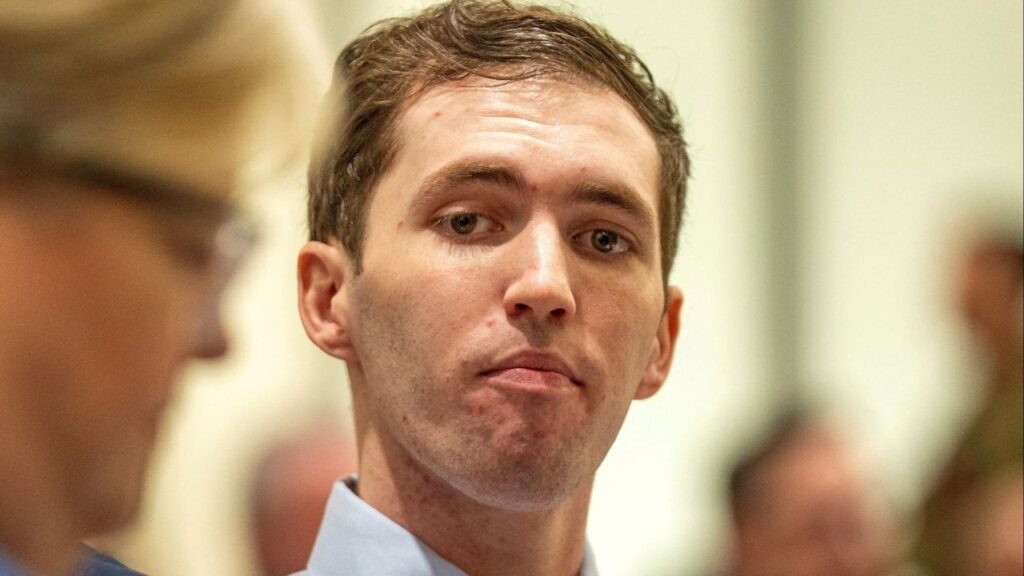Share
By Elizabeth Aguilera and Ricardo Cano, CalMatters
In Modesto, Claire Lazaro is working full time while caring for her kids with autism.
She worries about just how much progress her kids stand to lose now that they’re mostly without their critical hands-on services, such as her 11-year-old daughter’s one-on-one aide and her 12-year-old son’s inclusion specialist.
The days also seem to blur together now for Sherry Doyle, an Alameda County special education teacher who spends much of her time conferencing with parents, giving them crash courses on how to homeschool their children, while working into the night to piece together her digital classroom.
Across California, schools have physically shuttered as they make the unprecedented move toward online instruction amid the coronavirus pandemic. The virus has upended almost every facet of education in California and the nation — but perhaps no other student group stands to be more affected than students with special needs.
Nearly 800,000 students in California receive special education services, accounting for almost 13% of the state’s student enrollment. That number doesn’t include the tens of thousands of children under age 3 who receive specialized services through the state’s 21 regional centers — which provide support services to special needs individuals — under the Department of Developmental Services.
Parents, educators and advocates who spoke with CalMatters shared fears that special needs children will not only regress in academics, but lose some of the essential skills they’ve developed while working intimately with teachers, paraprofessionals and providers such as behavior and speech therapists.
Now, educators are scrambling to help their most vulnerable students, and working parents long accustomed to advocating for their special-needs children are essentially having to wear yet another hat: being their child’s teacher or therapist.
Big Adjustment
“It is pretty overwhelming,” Lazaro said. “I’m worried for my daughter because she is the one who really needs a lot of support, especially with math problems and reading comprehension. Even if I try to do it at home, I can’t do as much as they are doing at school. I don’t know if she is going to be able to catch up.”
Lazaro, a clinical director at the Stockton-based Valley Mountain Regional Center, has tried to maintain a schedule for her kids, Hannah and Gabriel, even as she works long hours from home.
Hannah, a fifth grader, uses an assisted communication device at school, gets speech therapy three times a week, and she has a one-on-one aide who helps her stay on task and with her work. Gabriel, in sixth grade, has an inclusion specialist at school who goes into his classroom to check on him and to offer assistance for anything he might need. The school district provides these services.
“They are not seeing any of that right now,” Lazaro said, adding that Hannah separately receives behavioral therapy three times a week and that is still going on, albeit virtually.
Lucia Soares, a Modesto mom, shares similar concerns for her son Daniel, 16, who is on the autism spectrum. Daniel attends general education classes with assistance from a one-on-one aide. He dreams of becoming a doctor.
Soares worries about how the downtime will affect Daniel’s learning, who she said “had such a great trajectory of growth over the last nine months.”
In between her own job in new product development for E&J Gallo Winery, Soares tries to help Daniel with his online assignments while she waits for virtual instruction to start and hopes he can get some individual screen time with his academic strategies teacher. Lucia and Daniel also take walks through their farm’s almond orchards, but their daily strolls are no substitute for the structure and routine of a normal school day that Daniel enjoyed and relied on.
Daniel’s track and field practices have stopped. There’s no more after-school therapy for him, either, though one of his therapists is still coming to the Soares’ home and he is still attending a support group with his peers.
But even those sessions are different. They’re smaller, and no longer allow fist bumps or close interaction — which causes confusion for Daniel and his friends. For autistic kids who have to work hard to socialize and understand social cues, social distancing is especially confusing, Soares said.
“They worked hard to realize that is the norm and we’ve been working on this, and now it’s ‘My world is blown,’ ” she said. “Social interaction is not the norm for them and they worked hard to do it, and this quarantine and self-isolation is really hard.”

Looking for Answers
As most California schools enter their third week of physical school closures, many are still determining how they will — and whether they can — continue services for students with special needs in a world of distance learning. Most teachers were unprepared to deliver instruction remotely, and across the state there remain disparities in families’ access to computers and reliable Internet service.
Those challenges are amplified for families with special-needs students, especially those with significant disabilities who rely on a team of educators and specialists for services, said Connie Kasari, a human development professor at UCLA’s Graduate School of Education and Information Studies.
A student who is minimally verbal, for instance, is likely to receive instruction from their special education teacher and an aide, while also receiving individual services from a speech therapist and an occupational therapist throughout the school day.
Experts said it’s unrealistic to expect parents to fill those specialized roles. Distance learning, they said, will not be feasible for all students with special needs.
“It’s one thing to put a child who can understand in front of a computer screen to do their lesson, do their homework, and quite another thing when the child doesn’t understand that,” Kasari said. “What is that child going to do? It could be that they’re just not getting any kind of education at all.”
The California Department of Education has given schools broad guidance telling educators to do the best they can to continue services laid out under students’ individualized education plans, while following the state’s social distancing and stay-at-home orders.
A statewide group of experts is coming up with more guidance on best practices for providing special education services, the department said, and the state is hosting a webinar Thursday on “distance learning innovations” for special-needs students.
Still, Kristin Wright, the state’s director of special education, acknowledged in a letter to schools that teachers and families faced “overwhelming challenges” providing for students with disabilities.
“Every student will not be able to access online learning in the same way that they accessed their education in their classrooms at school,” Wright said during a March 18 webinar. “But again, we need to think about each of our individual students and their (individualized plans) to ensure we do the best we can to meet their needs in these times.”
Complicating matters, some school officials at the onset of physical closures were skittish about immediately starting their online learning plans. They said state and federal guidance does not give them enough cover from potential litigation if they aren’t able to provide students with special needs a “free and appropriate education” that is guaranteed under federal law through distance learning.
Some parents of students with disabilities have said their children have received little to no instruction or services since schools’ physical closures. In some schools, teachers immediately reached out to families about helping them.
When asked Monday whether the state needed to give schools and educators more guidance beyond the broad advice offered by the state, Gov. Gavin Newsom said, “Yes, we need to do more, and we are trying to do that in real time.”
Newsom said he had a call with all 58 county superintendents scheduled Monday afternoon where he planned to have “a very sober conversation … about the expectations for the remainder of the school year.”
Nica Cox, president of the California Association of Resource and Special Educators, said that parents, special education teachers and specialists are in uncharted territory.
“The hardest part (for educators) is, how do they do those hands-on services?” she said.
Cox said distance learning is likely to significantly impact students with severe disabilities who require the most professional attention.
“You’ve got severe kids who, for six and a half hours a day, have a one-on-one aide and a teacher in their classroom, and they’re on this really strict and rigid routine because that’s what they need,” Cox said. “Now they’re at home, and a parent doesn’t know how to do that.”
Shannon Primer, a special education paralegal from Oceanside, is trying to maintain a structure and routine for her 18-year-old son, Austin, who has severe autism, but it’s been difficult.
“We’re not teachers, we’re not used to trying to structure the day, every day,” Primer said.
The nonpublic school Austin attends has been “proactive,” she said, giving her guidance on how to care for Austin, who she said must constantly be watched for his tendency to wander. She shares the tips with other parents on Facebook.
Primer fears Austin might regress and wonders how the pandemic’s economic impact will affect her ability to place him in a group home — placements are already in short supply — once he ages out of special education services on his 22nd birthday.
Primer, like other parents in similar situations, hopes that her school will offer compensatory services when normal instruction resumes.
“For my child, and most of the children like mine, online learning is not going to work. That’s just the bottom line,” Primer said. “My child is not going to sit still and look at a computer or iPad and Facetime someone and work on what his (education plan) goals are.”
The pandemic has forced some financially stressed families of students with disabilities into dire situations. Natalia Acosta, a Tracy mother of two toddlers with special needs, said she and her husband cannot continue to afford regular private insurance-funded therapy sessions for Jonathan, her 3-year-old autistic son.
Last week, Jonathan’s father had his salary cut 75%, and the family had to choose between paying their mortgage or paying for Jonathan’s therapy, which has a $30 co-pay per session for 21 sessions each month. The therapy, Acosta said, has been crucial for developing Jonathan’s behavioral and communication skills.
“I’m stressed because he has progressed and he needs the program,” Acosta said. “He’s asking for the teachers, and it’s disappointing not to be able to provide that for him. It’s also stressful because I don’t want him to be delayed or get worse with this situation. He’s very smart.”
Now, she hopes the Valley Mountain Regional Center, where both of her children are clients, will approve her emergency request to fund the sessions for Jonathan.
Regional Centers pay for needed services that schools and private insurance don’t cover, and now families are asking if the centers can step in as special needs kids are at home without their regular support services, said Amy Westling, executive director of the Association of Regional Centers. California also recently relaxed regulations to allow regional centers to approve virtual and online therapy sessions and to ease parent concerns about missing services, while also trying to protect their children, many of whom are medically fragile.
As schools shuttered their campuses, requests for specialized services have started to come in from families stretched to the max with kids off school and parents often trying to work from home, said Tony Anderson, director of the Valley Mountain Regional Center. The center provides services for 16,000 children in Amador, San Joaquin, Stanislaus, Calaveras and Tuolumne Counties.
“Our people are working from home calling everyone on their caseloads, checking to find out what they need,” he said. “Regional Center was not created to replace systems like schools, but when there is no school going on, parents turn to the centers for help.”
Teaching the Parents
In Humboldt County, about 3,200 students — more than 17% of the state total — receive special education, one of the state’s highest rates.
Mindy Fattig, special education executive director for the Humboldt County Office of Education, said special education teachers’ initial focus following the March 16 school closures was ensuring families had basic necessities. They each made several calls to students’ families as part of a “needs assessment,” asking whether they had access to Internet and technology and notifying them of food pick-up locations. A single mother told Fattig she didn’t have enough diapers for one of her children, prompting Fattig to go buy some at a local store.
While some of the county’s school districts have since partly continued special education through distance learning, others had yet to resume instruction and services, Fattig said. She was confident that, starting this week, all 32 districts in Humboldt County would be “providing some kind of instruction to the best of their ability” for students with special needs. She also acknowledged that distance learning is not practical for some students based on their disability.
Educators also focused on speaking with parents, helping them put a schedule in place for their child, fielding questions about how to respond to students’ behavioral challenges.
“They’re the teachers for their children now at home,” Fattig said, “and we need to provide them with tools and strategies, both behaviorally and academically, to help their family and their kids.”
Every morning now, second- and third-graders with mild to moderate disabilities watch from their computer screens as Sherry Doyle, the Alameda County special education teacher, leads them through exercises and games such as Simon Says. She and her students virtually gather for an hour, so they can see each other and socialize as if they were all in the same classroom again.
A significant chunk of Doyle’s days, though, are calling, texting, emailing and video chatting with parents. Originally, she had set aside about half an hour each week to connect with her students’ parents, but quickly found that much more time was necessary to assist parents who lack professional training and teaching experience.
It is a monumental task, so much so that one night last week, Doyle said she stayed up until 1:30 a.m. preparing her Google Classroom page with resources and materials. This included a “checklist” for parents to help guide their students through a daily schedule.
“I wish I could just take everything I know and give it to the parents,” Doyle said, “just so they have a sense of where to take things.”
CalMatters.org is a nonprofit, nonpartisan media venture explaining California policies and politics.
RELATED TOPICS:
Categories

Lululemon Athletica CEO to Step Down in January


















